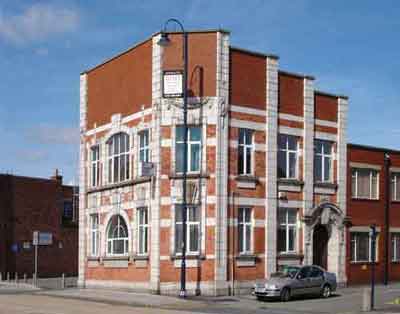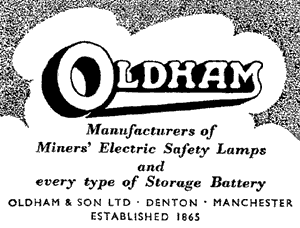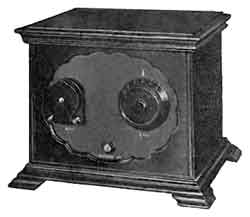Hyde Rd, Denton
In 1865, Joseph Oldham established a millwright general engineering shop, first in Newton, Hyde, and then on Stockport Rd, Denton, somewhere near St Lawrence's Church.
Subsequently, the business moved to the south side of Hyde Rd
where it traded under the name of Oldham & Son (i.e. Joseph Oldham and his son, Orlando Oldham). Slater's Trade Directories for 1903, 1909 and 1911 all show that
the factory was located between Nos 36 and 40 Hyde Rd (south side).
However, Kelly's Trade Directory for 1914 gives the address for the offices as 9 and 11 Hyde Rd (north side).

By 1887 the company was manufacturing machinery for the hatting industry. Shortly after 1887 it began to manufacture machinery and equipment for coal mining, which eventually included battery-powered miners' electric safety lamps. Initially the company bought in the batteries for these but it was dissatisfaction with the quality of batteries supplied to them that led the firm to move into the manufacture of their own batteries. One such miners’ safety lamp was their patented Type C lamp that was the first to be approved by the Home Office and this was added to their Permitted List on the 13 Mar 1913.

These products led to the manufacture of lead-acid automotive batteries for commercial vehicles, cars and motor cycles and over the years this expanded into the manufacture of traction batteries, which included submarine batteries. During the period of the Great War (1914/18) the company was given over to munitions, manufacturing shells for the war effort. In the 1930s it was advertising its lead-acid accumulators in the Radio Times, for use with wireless sets (radios), and it also ran its successful Lively 'O' advertising campaign. In the 1950s its Red Seal car batteries and heavy-duty batteries were popular. By the 1960s it was also manufacturing batteries to power forklift trucks.
Early valve wireless sets were mainly battery powered as many homes were without an electricity supply. Consequently, two useful Oldham products were the low-tension (typically 2 Volt) lead-acid accumulator and the high-tension (typically 120 Volt) dry battery. Accumulators were used to power cathode heaters inside thermionic valves of wirelesses, while the wirelesses themselves were powered by dry batteries.
An accumulator has positive and negative terminals made of lead alloy that connect to anode and cathode plates inside a glass container, the plates being immersed in an electrolyte of dilute sulphuric acid. A vented removable cap is provided in the top of the accumulator to enable the correct acid level to be maintained.
When an accumulator was discharged it was taken to a local garage or ironmongers where it was exchanged for a fully charged one while a discharged high-tension dry battery was discarded and replaced.
In the 1930s Oldham’s were marketing their Lively ‘O’ brand of accumulators and dry batteries for use with wireless sets. The range included three standard accumulators and four dry batteries. The accumulators were the Type O25 (25Ah for 2-valve sets), O50 (50Ah for 3-valve sets) and O75 (75Ah for 4-valve sets). The corresponding dry batteries were graded at 66, 99, 108 and 120V.
Ampere hour = Current (A) x discharge time (h)
∴ at a 20-hour rate of discharge an O25 accumulator
could supply a current of 50Ah/20h = 2.5A for 20 hours.



Centre: An Oldham Type O50 2V lead-acid low-tension accumulator.
Right: An Oldham 108V high-tension dry battery.
After hat manufacturing, the original partnership of Oldham & Son grew to become the largest employer in Denton with over 1,000 employees at one stage. Following on from Joseph Oldham (c.1833-1902) and Orlando Oldham (1856-1925), the business passed to Joseph’s grandson, John Oldham (1896-1965). As the 20th century progressed there were structural changes to the company as shown in the timeline below.
Orlando Oldham was born at Hyde, Cheshire, in 1856 to Joseph Oldham and Martha Sykes who were married in the Hayfield District of Derbyshire in 1852. He married Ada Hannah Wright at Ashton-under-Lyne, Lancashire, in 1884. His wife was born at Denton, Lancashire, in 1859. In 1911 he was resident with his wife and family at Cambridge House, Hyde Rd, Gorton, Manchester. His occupation was given as a manufacturing mechanical engineer for collieries and hat manufacturers. He died at Rusholme, Manchester, on the 19 Jul 1925, aged 69 years.
1865The company was founded by Joseph Oldham as a partnership styled as Oldham & Son.1920Oldham & Son became a private limited company styled as Oldham & Son Ltd.1947Oldham & Son Ltd became a public limited company. The suffix, 'plc', for a 'public limited company' was not introduced until 1980.1969The company became Oldham Crompton Batteries Ltd as the result of a merger. ‘Crompton’ in the new name was derived from Crompton Parkinson, part of the Hawker Siddeley aerospace group, which also manufactured batteries.1971The Company was acquired by Carlton Industries, part of London Merchant Securities.1972The company became Oldham Batteries Ltd, a subsidiary private company.2002The Denton premises closed and were razed to the ground except for the offices on the corner of Hyde Rd and Nelson St.